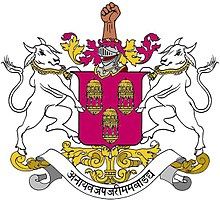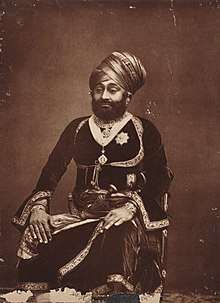Dhrangadhra
Dhrangadhra (![]()
Dhrangadhra | |
|---|---|
Town | |
| Nickname(s): Pink City | |
 Dhrangadhra Location in Gujarat, India  Dhrangadhra Dhrangadhra (India) | |
| Coordinates: 22.98°N 71.47°E | |
| Country | |
| State | Gujarat |
| District | Surendranagar |
| Elevation | 64 m (210 ft) |
| Population (2011) | |
| • Total | 75,133 |
| Languages | |
| • Official | Gujarati, Hindi, English |
| Time zone | UTC+5:30 (IST) |
| Vehicle registration | GJ 13 |
| Website | gujaratindia |
Etymology
In Sanskrit dhrang means a stone, and dhara means the earth. It is believed that because of the strong and widespread yellow stone bedrock found immediately under the soil of the place, the town is thus named.
History


Dhrangadhra has a long history starting from Lower Paleolithic Period. The River named Falku is passing from Dhrangadhra town. The evidence come from the river bed of the Bhadar river which flows along with the Dhragadhra taluka. Moreover, there are many Harappan-period sites. Recent studies in the area suggests that the Dhragadhra and Halvad taluka was the frontier of the so-called sorat Harappans which bifurcates the Sidhi Harrapans of Kutch &andSindh. These are recent studies made by Arun Malik, a PhD scholar of The M.S. University of Baroda and now he is with Archaeological Survey of India.
Modern history
Dhrangadhra grew from Jhalawad Princely State, which was founded about AD 1090. This state was ruled by the Jhala Rajputs. In 1735, Dhrangadhra was founded as its capital. The state was then renamed Dhrangadhra-Halvad state from the initial name of Kuwa, Halwad.
In 1941 the princely state of Dhrangadhra had a population of 94,417 living in an area of 1,167 square miles.[1]
In 1925, India's first soda ash factory was founded in Dhrangadhra. It was taken over by Shreyans Prasad Jain, who established the Dhrangadhra Chemical Works (now known as DCW) in 1939. Now, DCW is the largest industry there, and is the main source of employment.[2]
In 1948, the state of Dhrangadhra was made part of the Jhalawad district in Saurashtra. In 1956 it became part of Gujarat. Dhrangadhra also contains the Gobar gas plant, which is located at Navalgadh village.
Geography
Dhrangadhra is located at 22.98°N 71.47°E.[3] It has an average elevation of 64 metres (209 feet).
Demographics
As of 2001 India census,[4] Dhrangadhra had a population of 75,133. Males constitute 54% of the population and females 46%. Dhrangadhra has an average literacy rate of 68%, higher than the national average of 59.5%: male literacy is 75% and, female literacy is 59%. In Dhrangadhra, 12% of the population is under 6 years of age. Juna Ghanshyamgadh is also located near Dhrangdhara.
With both sacred and secular architecture influenced by local medieval history, Dhangadhra today is a modern town with the population of about 100,000, which includes Hindus, Muslims, Zoroastrians, Jains and Christains. The affluent are traders in the local cotton and salt trade that has existed for over 300 years, while the majority are farmers and shopkeepers. It has industries such as DCW with chemical products, Mausam brand food products such as Spices, delicious pickles in various flavours, sauces, pastes, sherbats, and ketchup by K.P. Industries and many other industries in GIDC area. The provincial town boasts several hospitals, schools and a college. Along with regular telephone and portal services, mail and courier facilities are also available in the town.
The Rabari and Bharwad farming communities that raise cattle, sheep, goat and camels live in villages surrounding the town. Each summer, the outskirts of the town also hosts a camp of snake charmers.
Dhangadhra is a railway junction on the Western Railway (India) and is connected to Ahmedabad and other regions of Kutch and Saurashtra by road and rail links. There are auto rickshaws (three-wheeler hooded taxis) and larger un-hooded three-wheelers called Chhakada which typically run on modified Royal Enfield engines, are available for travel within the town and surrounding areas.
Dhrangadhra is also the headquarters of the Deputy Conservator of Forests, which is responsible for the Wild Ass Wildlife Sanctuary on the Little Rann of Kutch, home to the last three species of Asiatic Wild Ass.
Culture and places of interest
•The Radha Krishna Temple at Army Cantonment • Mausam Pickle Factory(Authorization needed) • The Palace(Authorization needed) • Falku Dam • Phuleshwar Mahadev Temple • BAPS Swaminarayan Temple • Rokadiya Hanuman Temple, it has a lot of tortoises that are very old. • khareswar mahadev (narali) • DCW (dhrangadhra chemical works) • jogasar lake •
Culture
Temples, step-wells, palaces and mosques from various historical periods exist in various states of preservation. There are more than 100 places of worship, and ancient art and craft traditions such as stone sculpture, jewellery making, tie and dye fabrics and embroidery prosper.
B.A.P.S Swaminaryan Temple Dhrangadhra, GJ SH 7, Panchavati Society [Pramuk Swami Mandir]
Bhagwatdham,Shri Swaminarayan Gurukul, Halvad road, Near Ahmedabad- Maliya Bye Pass, GJ SH 7, Bhagwatdham Society, Dhrangadhra
Shree Swaminarayan Sanskardham Gurukul, Halwad road, Dhrangadhra[5]
One of the ancient ek-dantay Ganpati temple, famous as Jogasar is located in Dhrangadhra
Shitla Maa Temple, Dhrangadhra is located in the northern suburban area
There is even a Deshal Bhagat temple [Desal Bhagat of Rajput samaj] situated outside the city, believed that god himself took the form of Saint Deshal Bhagat one time.
Also there is ashram of Valbai Maa, Bhala Hanumaan Mandir, Fuleshwar Mahadev temple, Rokadiya Hanumanji temple, Bala Hanumanji temple, Dariyalal temple, Jalaram bapa temple, Shakti ma temple, etc.
There is a dargah of Shahid Muhammed Musa in the Raj darabar(man mahelat)
Man Mehlat Palace [Raj mahel], Dholidhar, Dhrangadhra in the town centre is well preserved
Ajitnivas Palace complex, DCW Colony, Dhrangadhra is another palatial complex located southerly
Taranga Vihar Dham located far along highway near Chuli after Saladi railway station is a popular destination close to Dhanrgadhra.
Matrivav, Kankavati - a historic well preserved step-well is located 15 km far northwesterly
Dhrangadhra is famous for its Stone artwork. The Government of Gujarat (Department of Industries and Mines and Commissioner of Geology & Mining) has set up two prestigious Stone Artisan Park Training Institutes (SAPTIs) - one each at Dhrangadhra and Ambaji in the State.[6] Training centre in Dhrangadhra is located 3 km from the town on Halvad bypass road, near railway crossing. Traditionally, the 'Sompura' cast from Dhrangadhra have built and designed many Jain derasars - a type of temple of Jain people all over Gujarat and India. It is known that the temple of Somnath is built by the Sompura cast living in Dhrangadhra.
References
- Columbia-Lippincott Gazetteer. p. 511
- "About DCW". Archived from the original on 3 January 2012. Retrieved 3 February 2012.
- Falling Rain Genomics, Inc - Dhrangadhra
- "Census of India 2001: Data from the 2001 Census, including cities, villages and towns (Provisional)". Census Commission of India. Archived from the original on 16 June 2004. Retrieved 1 November 2008.
- http://www.ssgd.org
- "Archived copy". Archived from the original on 10 January 2016. Retrieved 7 June 2016.CS1 maint: archived copy as title (link)